Wai-Fah Chen.The Civil Engineering Handbook
Подождите немного. Документ загружается.

Quality of Urban Runoff 33-11
•Characterize temporal and spatial details of quality and quantity of urban runoff;
•Perform frequency analysis to determine return periods for urban runoff quality parameters such
as concentrations and loads;
•Determine configurations for urban runoff control options with regard to magnitude and location;
•Provide a drive for a receiving water quality model with quality and quantity of urban runoff as
inputs; and
•Provide input for cost to benefit analyses.
Modeling Categories
When considering urban runoff quality, modeling can be useful in a planning, design, or operational
situation. Three general modeling categories are available for approaching situations and are as follows
(EPA, 1995a):
• Land Use Loading Models: These models provide pollutant loading as a function of the distribution
of land use within the watershed. In this approach, water quality parameters may either be
represented as constant concentrations or as unit loadings. Overall runoff quality is determined
as a weighted sum of characteristic concentrations for the catchment.
• Statistical Methods: Often called the EPA Statistical Method, this technique is a more sophisticated
rendering of Land Use Loading Models discussed above. It recognizes that Event Mean Concen-
trations (EMCs) are not constant but rather are distributed log normally. Combining the EMC
distribution with distributed runoff volumes will yield the load distribution.
•Buildup/Washoff Models: These models attempt to simulate the “buildup” process where pollut-
ants collect during dry weather periods and then “washoff” during storm events. By considering
time periods, rainfall events, and management practices, the basic processes that control the quality
of urban runoff can be investigated. For additional information on buildup/washoff models, see
for example Novotny and Chesters (1981) or Delleur (1998).
Data
Regardless of the selected modeling approach, two types of data will be necessary. First, fundamental
input data such as rainfall information, land slope, and water quality data will be necessary to compile
most models. Potential sources for necessary water quality modeling data are contained in Table 33.8.
Additionally, individual state agencies (such as departments of natural resources, departments of envi-
ronmental management, or EPA) may be able to provide guidance on data collection. The second type
of data represents the quality and quantity parameters the model attempts to characterize. It should be
collected from sites within the modeled catchment and is used for the calibration of modeling results.
Point Source Models
Models analyzing point and nonpoint source pollution have been developed. Most point source modeling
techniques are designed for modeling stormwater and combined sewer overflows. The Storm Water
Management Model (SWMM) is a widely used model, which provides a complete simulation of the
hydrologic, hydraulic, and environmental aspects of urban drainage systems. SWMM was developed in
the 1970s for the EPA, is public domain, and is frequently updated. It performs both continuous and
single-event simulation throughout the model and can perform quantity and quality modeling in detail.
Each block of the model can simulate an aspect of urban runoff and jointly the model simulates the
integrated urban water system. Figure 33.3 provides a schematic of principal blocks in the SWMM
program. Other models of similar capabilities have been developed to simulate combined sewer systems
and their effects on receiving waters. Such models include Statistical by EPA, STORM by HEC (Hydrologic
Engineering Center) and others developed by various agencies. In some cases a particular model to be
used may be specified. Given the dynamic nature of modeling and software development, evaluation of
several models is necessary to ensure an appropriate model is selected. The MOUSE system (1992) is
© 2003 by CRC Press LLC
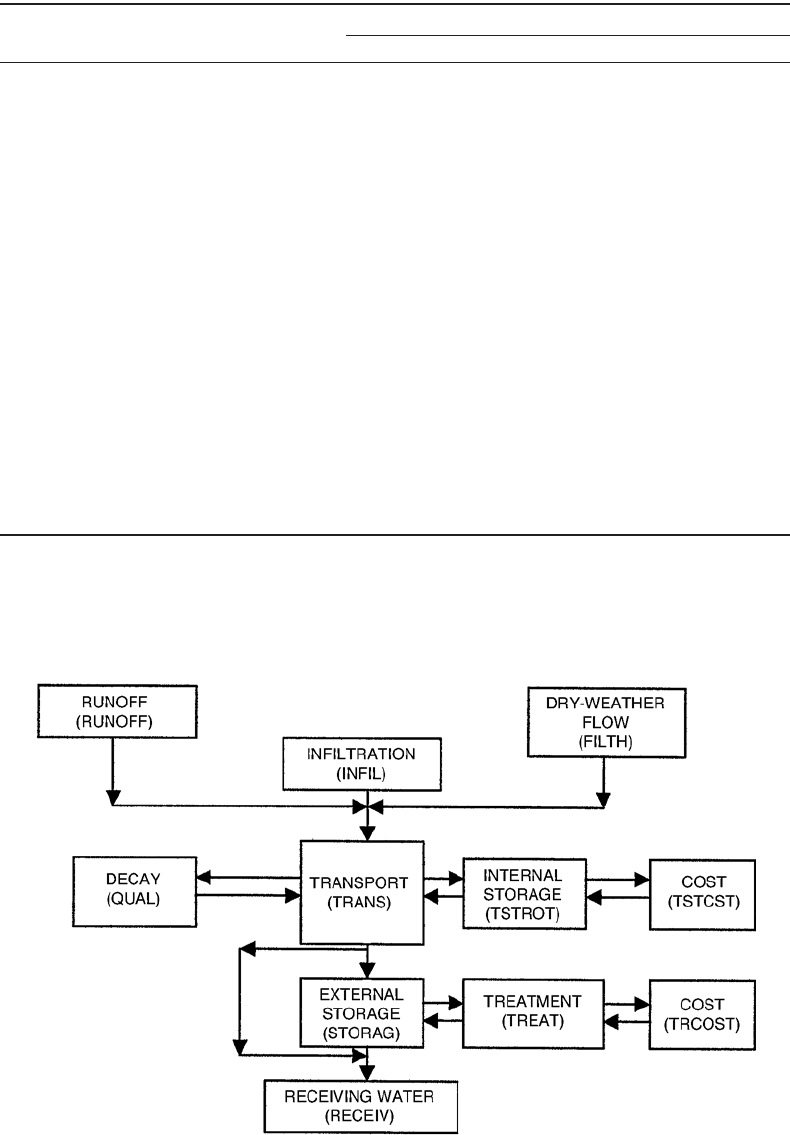
33-12 The Civil Engineering Handbook, Second Edition
TA BLE 33.8 Data types and possible data sources (EPA, 1997b)
Source
Data Type Federal Agencies State Agencies Local Groups
Land
Geometry
USGS
US Army Corps of Eng.
Division/District Offices
EPA
Special studies Planning agencies
Stream Flow USGS gage records and low
flows (available through EPA)
Publications on low flows
Basin plans
Universities
Planning agencies
Water Quality
Data
EPA STORET
USGS
US Fish & Wildlife Service
Regulatory agencies
TMDL studies
State Department of Health
Studies by regional planning
groups
Discharger’s studies
Universities
Wastewater
Loads
EPA Permit Compliance System
(PCS)
Discharge Monitoring Reports
(DMR)
Municipal and industrial
discharger’s plant records
Nonpoint
source loads
EPA STORET, USGS and US
Fish and Wildlife Service;
urban runoff data available
from EPA NURP;
precipitation and
meteorological data available
from NOAA National
Climatic Weather Center; land
use data from USGS; soil
characteristic data from USDA
Soil Conservation Service
Urban runoff data from special
studies; precipitation and
meteorological data from State
planning agencies and local
airports; land use data from
State planning, agricultural and
geological agencies.
Urban runoff data from regional,
city and country studies;
precipitation and
meteorological data from local
and county planning agencies
and local airports; land use and
soils characteristics data from
regional and county planning,
agricultural, and geological
agencies.
FIGURE 33.3 Components of the Storm Water Management Model (SWMM). Subroutines are in parentheses (EPA,
1971).
© 2003 by CRC Press LLC

Quality of Urban Runoff 33-13
frequently used in Europe. Harremoës and Rauch (1996) and Krejci (1998) have advocated the integrated
design and analysis of drainage systems, including sewers, treatment plants, and receiving waters.
Nonpoint Source Models
Nonpoint source modeling is a relatively new and rapidly evolving practice as much focus is being shifted
towards eliminating nonpoint source pollution to improve water quality. Traditionally, models have
focused on estimating the quantity of peak flow. However, much has been done recently to estimate the
quality of runoff and receiving waters. A number of models have been developed to estimate and analyze
urban nonpoint source pollution, and the following is a brief list of popular models:
•Storage-Treatment-Overflow-Runoff Model (STORM) (ACE, 1974)
•Stormwater Management Model (SWMM) (Huber and Dickinson, 1988)
•Hydrologic Simulation Program-FORTRAN (HSP-F) (Bicknell et al., 1997).
The above models were developed to analyze water pollution from nonpoint urban sources. Due to
the geo-spatial variation involved with nonpoint source modeling, an additional tool is needed to further
represent constituents over the watershed. Hence, the model can be linked to a geographic information
system (GIS). Integrating the nonpoint source model with a GIS tool can provide many benefits including
(Bhaduri, 2000):
•model-estimated nonpoint source pollution areas can be identified over the watershed;
• the integrated tools can produce useful information on changes in water quality following imple-
mentation of pollution reduction approaches; and
• it can also evaluate alternative management practices for the control of nonpoint source pollution.
The long-term hydrologic impact assessment (L-THIA) model has been developed to estimate the
effect of urbanization on the quality of runoff and receiving waters. The nonpoint source model is based
on the curve number (CN) method for estimating the quantity and quality of runoff. The model has
been integrated with Arc/INFO software as a GIS (Geographic Information System) application.
Figure 33.4 shows components of the L-THIA/GIS applications and steps involved in the analysis.
Modeling Considerations
The following fundamentals should be considered regardless of the model chosen or the type of pollution
modeled (WEF, 1989 and WEF/ASCE, 1998):
•Develop a clear statement of the project objective. The need for quality modeling should be
confirmed to prevent unnecessary modeling.
•The simplest model that will satisfy all project objectives should be chosen. A screening model,
such as a statistical or regression method, may help determine if the problem calls for more
complex models.
•Use a quality prediction approach that is consistent with available data.
•Predict only the quality parameters that are needed to analyze the problem. For example, do not
use storm specific EMCs when the analysis only requires information to a seasonal or annual detail.
•When a model is chosen, perform a sensitivity analysis to become acquainted with the model.
•Have one data set available for calibration of the model and another to verify results obtained.
33.5 Best Management Practices
The gap between water quality criteria and pollutant concentrations found in urban runoff illustrates
the urgent need to develop strategies to control runoff and improve quality of receiving waters. Regula-
tions and public awareness have lead to the initiation of best management practices (BMPs) to provide
comprehensive solutions.
© 2003 by CRC Press LLC
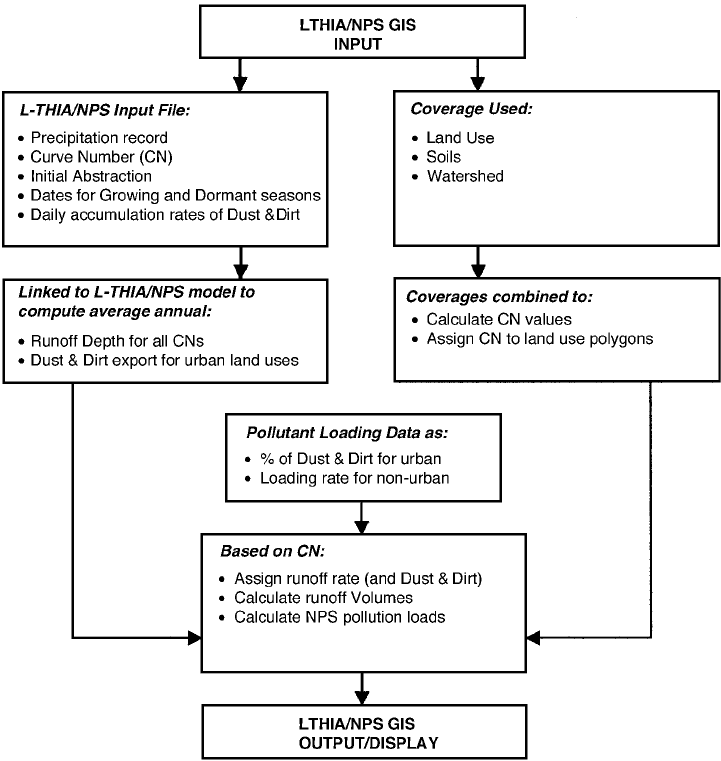
33-14 The Civil Engineering Handbook, Second Edition
A BMP can be viewed as a device, practice, or method for removing, reducing, or preventing storm-
water runoff pollutants from reaching receiving waters (URS/ASCE/EPA, 1999). Selecting a best man-
agement practice involves technical and non-technical considerations. While technical issues are usually
considered first, the non-technical issues can present many challenges. Major non-technical selection
issues include federal, state, and local regulations, perceived water problems, uses of receiving water
bodies, cost, and community perception. Technical issues include source control, local climate, design
storm size, soil erosion, stormwater pollutant characteristics, multi-use management facilities, mainte-
nance, and physical and environment factors (slope, area required, soil, water availability, aesthetics and
safety, and additional environmental conditions) (WEF/ASCE, 1998).
Point Source Programs
The EPA has established a water quality based Combined Sewer Overflow Control Policy to serve as the
framework for the control of CSOs through the NPDES (National Pollution Discharge Elimination System)
permitting program. The policy encourages adoptions of overflow controls based on community need
while meeting local environmental objectives. The fundamental principles are as follows (EPA, 1994):
FIGURE 33.4 Components of L-THIA/nonpoint source (NPS) GIS applications and general steps involved in an
analysis (Bhaduri et al., 2000).
© 2003 by CRC Press LLC
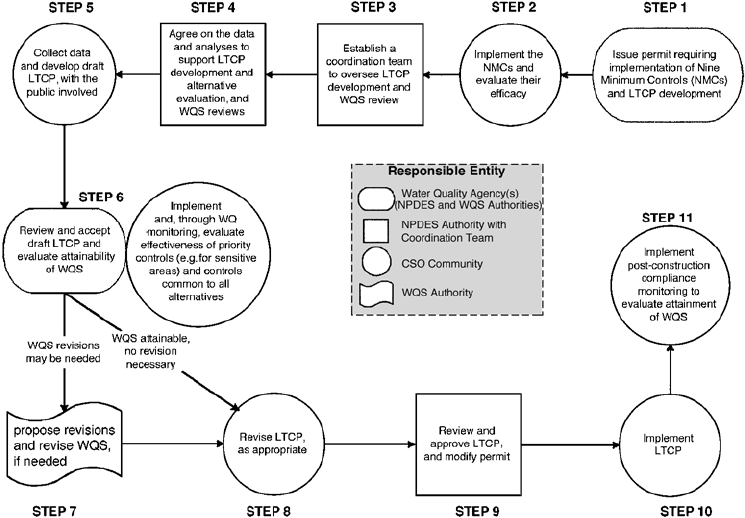
Quality of Urban Runoff 33-15
1. clear levels of control to meet health and environmental objectives;
2. flexibility to consider the site-specific nature of CSOs and find the most cost-effective way to
control them;
3. phased implementation of CSO controls to accommodate a community’s financial capability; and
4. review and revision of water quality standards during the development of CSO control plans to
reflect the site-specific wet weather impacts of CSOs.
EPA guidance documents for the Policy are continuously published and updated. Under the Policy,
the first deadline occurred in 1997 requiring communities with CSOs to implement nine minimum
technology-based controls. It was determined that implementation of the controls would reduce the
prevalence and impacts of CSOs and would not require significant engineering studies or major con-
struction. The nine minimum controls (NMC) are (EPA, 1995b):
1. Proper operation and regular maintenance programs for the sewer system and the CSOs
2. Maximum use of the collection system for storage
3. Review and modification of pretreatment requirements to assure CSO impacts are minimized
4. Maximization of flow to the publicly owned treatment works for treatment
5. Prohibition of CSOs during dry weather
6. Control of solid and floatable materials in CSOs
7. Pollution prevention
8. Public notification to ensure that the public receives adequate notification of CSO occurrences
and CSO impacts
9. Monitoring to effectively characterize CSO impacts and the efficacy of CSO controls
The Policy also requires the development of a comprehensive Long Term Control Plan (LTCP). The
LTCP should be integrated with review and revision of water quality standards. The following steps and
Fig. 33.5 are useful in developing an effective LTCP that will ensure measures will be sufficient to meet
water quality standards provided in EPA guidance documents (EPA, 2001a).
FIGURE 33.5 Steps for developing an effective long-term control plan (EPA, 2001a).
© 2003 by CRC Press LLC
33-16 The Civil Engineering Handbook, Second Edition
Step 1: Issue permit requiring implementation of the NMCs and LTCP. A permit or other enforceable
mechanism requiring immediate action by the CSO community is issued the NPDES authority.
Step 2: Implement NMCs and evaluate their efficacy. The CSO community should evaluate the early
level control of the NMCs in managing the number and quality of overflows. Ultimately the NMCs
should be incorporated into the LTCP.
Step 3: Establish a coordination team to oversee LTCP development and WQS. The NPDES forms
a team that will direct the development of a draft LTCP, promote timely discussion, and provide technical
assistance. The coordination team should at minimum include decision-making representatives from the
CSO community, State Water Director, and NPDES authority.
Step 4: Agree on the data and analyses to support LTCP development and alternative evaluation
and WQS reviews. This step works toward early agreement on the planned process (i.e., milestones and
dates) and scope of the LTCP. Additionally, type and amount of data and analyses necessary for control
alternatives and water quality standards should be determined.
Step 5: Collect data and develop draft LTCP with public involvement. Following data collection, a draft
LTCP is developed which evaluates the cost, feasibility, performance, water quality benefits, and sensitivity
for each control. Other sources of pollution are identified that influence CSO receiving water quality.
Step 6: Review and accept draft LTCP and evaluate attainability of WQS. A draft LTCP is submitted
to the NPDES authority and the State Water Director for review. The CSO community works with the
reviewing agency to confirm the basis of the LTCP is acceptable to achieve WQS. Draft LTCP is revised
if insufficient.
Step 7: Propose revisions and revise WQS if needed. To reach this step, all involved decision-making
parties have agreed that the LTCP contains adequate data and information for the selection of CSO
controls and needed WQS revisions have been identified. The state should quickly seek to revise WQS.
Step 8: Revise LTCP as appropriate. The CSO community would have to revise the draft LTCP if the
WQS decisions differ from those anticipated or if the previously implemented controls have not per-
formed as predicted.
Step 9: Review and modify LTCP and modify permit. The NPDES authority coordinates that review
of the revisions and, if appropriate, approves the final LTCP. An enforceable permit is then issued requiring
implementation of the approved LTCP.
Step 10: Implement LTCP. Approved control measures are implemented and approved operations
plans and post-construction compliance monitoring program is carried out.
Step 11: Implement post-construction compliance monitoring to evaluate attainment of WQS.
Monitoring data will be used to support changes to the operations plan if it is shown that implemented
control measures are contributing to the non-attainment of WQS.
A similar policy (currently in the form of a rule) has been submitted by the EPA for SSO control. The
rule seeks to revise existing NPDES permit regulations to improve the operation of municipal sanitary
sewer collection systems, reduce the frequency and occurrence of sanitary sewer overflows, and provide
more effective public notification when SSOs do occur. The rule largely addresses SSOs and will reduce
overflows, provide better information for local communities, and extend lifetime for sanitary sewer
systems. Requirements of the proposed rule quoted from the EPA include (EPA, 2001c):
• Capacity Assurance, Management, Operation, and Maintenance Programs. These programs will ensure
that communities have adequate wastewater collection and treatment capacity and incorporate many
standard operation and maintenance activities for good system performance. When implemented,
these programs will provide for efficient operation of sanitary sewer collection systems.
• Notifying the Public and Health Authorities. Municipalities and other local interests will establish
a locally tailored program that notifies the public of overflows according to the risk associated
with specific overflow events. EPA is proposing that annual summaries of sewer overflows be made
available to the public. The proposal also clarifies existing record-keeping requirements and
requirements to report to the state.
© 2003 by CRC Press LLC
Quality of Urban Runoff 33-17
• Prohibition of Overflows. The existing Clean Water Act prohibition of sanitary sewer overflows that
discharge to surface waters is clarified to provide communities with limited protection from
enforcement in cases where overflows are caused by factors beyond their reasonable control or
severe natural conditions, provided there are no feasible alternatives.
• Expanding Permit Coverage to Satellite Systems. Satellite municipal collection systems are those
collection systems where the owner or operator is different than the owner or operator of the
treatment facility. Some 4800 satellite collection systems will be required to obtain NPDES permit
coverage to include the requirements under this proposal
Total Maximum Daily Loads
Section 303 (d) of the Clean Water Act requires states to identify problem water bodies and develop total
maximum daily loads (TMDLs), which set the maximum amount of pollution that a water body can
receive without violating CWA water quality standards. The load includes end-of-pipe pollutants from
point sources and nonpoint sources. Therefore, if nonpoint source pollution cannot be reduced, then
more treatment is required for wastewater and more control is required for combined sewer systems.
This is in response to the over 300,000 rivers and shoreline miles and five million acres of lakes across
the U.S. that have been identified as polluted. The EPA defines a TMDL as a “pollution budget” and
asserts that applicable water quality standards can be attained and maintained. If a state fails to develop
TMDLs for their water bodies, the EPA is required under section 303 (d) of the Act to develop a priority
list for the state and make its own TMDL determination. The EPA affirms that the TMDL rule will
provide a comprehensive list of all U.S. polluted waters, require states to clean up polluted waters with
cost-effective measures, and assure that TMDLs include implementation plans with defined milestones
and timelines (EPA, 2000c).
This TMDL control is likely to impact Midwestern states affected by CSOs as well as CFOs (confined
feeding operations). The program requires an analysis of the watershed including developing a model to
provide an accurate assessment of the pollution present within the watershed. A TMDL will consider all
sources contributing to the depletion of water quality within the watershed. Therefore, developing load
allocations for a TMDL plan is a critical process. Figure 33.6 illustrates the appropriate steps taken in
developing load allocations for the implementation of a TMDL plan. As shown in the figure, when
information needed to develop load allocations is not present, the TMDL process becomes very compli-
cated and additional time is required (EPA, 2000c).
Components of a TMDL plan include identification of polluted waters, clean-up schedule, the TMDL
program, and an implementation plan. The following are the elements of a TMDL program (EPA, 2000c):
• water body name and location, pollutant(s), and water quality standard;
• amount of pollutant allowable to meet standards, load reduction needed to meet standards, sources
of pollutant, wasteload allocation for point and nonpoint sources, and an implementation plan;
•factor of safety to account for seasonal and other variations; and
• public feedback and involvement prior to submission.
The implementation plan accounting for all sources of pollution will include (EPA, 2000c):
•a list of actions needed to reduce loadings and a schedule of implementation;
•“reasonable assurances” that actions will be implemented (an NPDES permit is an assurance for
point sources. For other sources, load allocations in a TMDL must apply to the pollutant, be
implemented expeditiously, be accomplished through effective programs, and be supported by
adequate water quality funding.);
•a monitoring plan with milestones;
• plans for revising the TMDL if no progress is made; and
• water quality standards must be met within 10 years.
© 2003 by CRC Press LLC
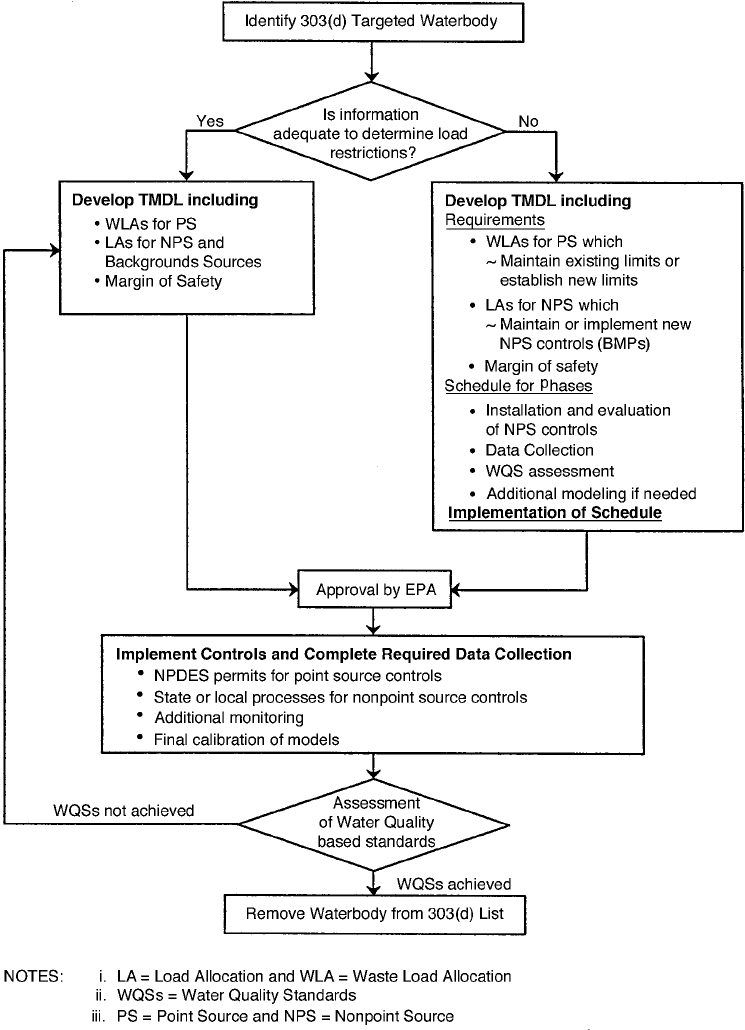
33-18 The Civil Engineering Handbook, Second Edition
A TMDL plan may require additional control measures (such as structural measures) to retrieve the
quality of a waterbody to the specified criteria. The monitoring plan used to collect data will continue to
assess the quality of the watershed. A waterbody is removed from the 303(d) list upon meeting water criteria.
Otherwise, the TMDL must be modified by gathering additional data and information (EPA, 2000c).
FIGURE 33.6 Flow chart showing steps taking in the development of a TMDL plan (EPA, 2000c).
© 2003 by CRC Press LLC
Quality of Urban Runoff 33-19
Nonpoint Source Programs
A few selected nonpoint source programs are detailed below as they apply to the reduction of nonpoint
source pollution.
The nonpoint source program (EPA, 2000a) is a state level program that focuses on educating the
general public and implementing control measures termed BMPs to reduce nonpoint source pollution.
In 1987, Congress enacted Section 319 of the Act to control nonpoint source pollution. Under Section 319,
EPA provides technical and program assistance along with funding to the states. The National Monitoring
Program (NMP) by the EPA as part of Section 319 establishes that the EPA shall collect information and
make the following available:
• information concerning the costs and efficiencies of BMPs for the reduction of nonpoint source
pollution; and
• data showing the relationship between water quality and implementation of various management
practices.
The two objectives of Section 319 are to evaluate the effectiveness of watershed technologies designed
to control nonpoint source pollution, and to improve the understanding of nonpoint source pollution.
Coastal Zone Management and Reauthorization Act (CZARA) of 1972 and Amendments of 1990
required coastal states and territories to develop programs to protect coastal water from runoff pollution.
The program is administered by EPA and the National Oceanic and Atmospheric Administration.
The National Pollution Discharge Elimination System (NPDES) required municipal and industrial
stormwater discharges to submit an NPDES permit under Phase I (1990) of Section 402 of the Clean
Water Act. Phase I included municipalities with population over 100,000 and industrial stormwater
discharges including construction sites of 5 acres or more. Phase II (1999) required municipalities with
populations of less than 100,000 associated with commercial operations and light industries to develop
stormwater management plans (EPA, 2000d).
Intermodal Surface Transportation Efficiency Act (ISTEA of 1991) is designed to improve the quality
and condition of national highways and transportation systems. The act provided provisions for the
mitigation of water pollution due to highway runoff.
Other nonpoint source programs include the National Estuary Program (NEP) established by the
CWA and the pesticides program under the Federal Insecticide, Fungicide and Rodenticide Act. NEP
focuses on pollution in high priority estuaries. The pesticides program concentrates on pesticides threat-
ening surface and ground waters.
Structural Measures
The control of point and nonpoint source pollution may require the use of a structural measure. A
structural measure is a strategy for control of the quality and quantity of urban runoff. Such measures
impose additional capital and annual operations costs plus maintenance costs.
Various structural measures used to control urban runoff have evolved over the years in light of the
recent regulations. Table 33.9 summarizes the opinions of senior stormwater quality management pro-
fessionals about the design robustness of various stormwater quality controls. The effectiveness of such
measures is site specific, and the removal of constituents from urban runoff depends on environmental
and physical factors.
We tlands can act as water retention facilities due to their capacity to store water. For example, a 1-acre
wetland with a depth of 1 foot can hold over 330,000 gallons of water. Wetlands can provide several
functions including water quality improvement, flood storage and the routing of stormwater runoff,
cycling of nutrients and other material, habitat for fish and wildlife, recreational activities, education and
research, and landscape enhancement. Performance has varied based on the location, type of wastewater,
wetland design, climate, weather disturbance, and daily or seasonal variability. Therefore, it is very difficult
to predict the performance of any given wetland system. Constructed wetlands can be surface flow,
© 2003 by CRC Press LLC
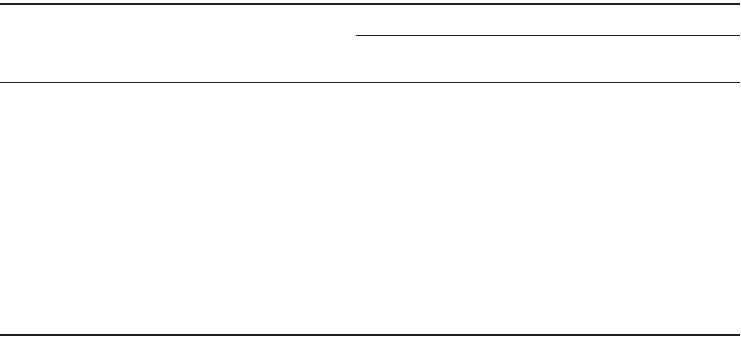
33-20 The Civil Engineering Handbook, Second Edition
subsurface flow, or a hybrid system. Subsurface flows have been proved to provide the highest removal
efficiencies due to the presence of a substrate system, but are more expensive than surface wetlands.
Communities have several alternatives when controlling excessive flows while maintaining water qual-
ity criteria. Rehabilitation of sewers may improve the system, but will not provide additional capacity.
Equalization basins are a viable alternative when CSOs and SSOs present a quality and quantity problem
for a community. The combined flow is stored in the basin during wet weather flow and then discharged
to the treatment plant during low peak periods. This provides for a consistent composition of wastewater
(i.e., flow and constituents). An equalization basin can also store stormwater, which eventually may be
discharged to a treatment plant or treated through a different system. The basin is typically designed to
handle the first burst of stormwater, which carries the highest concentration of pollutants. This assures
that overflow from the basin does not contribute a significant amount of pollution.
The majority of point source control practices target combined sewers. The type of CSO pollution
abatement technology used may depend upon climate, topography, geologic conditions, and receiving
water criteria of a particular location. A combination of technologies is often used. Most CSO structural
practices can be grouped into the following four categories: offline storage/treatment, treatment, inline
storage/control, and miscellaneous BMPs (WEF, 1989). Offline storage and treatment technologies divert
combined flows into holding devices separated from the main flow and hold them until treatment capacity
is available. In some cases, solids and floatables are removed during holding. CSO treatment facilities
typically remove solids and floatables, chlorinate, and achieve some BOD removal. Inline storage and
control methods work to store and divert flows online to ensure all combined flow is treated. Various
best management practices, such as diversion weirs and system cleaning and rehabilitation, have been
used successfully to control CSOs.
Defining Terms
Atmospheric deposition — The settling of pollutants by wind from various sources such as traffic,
construction, and industrial sites.
BMP — Best Management Practice.
CFO — Confined Feeding Operation.
TA B L E 33.9 Robustness of Best Management Practice Design Technology (WEF/ASCE, 1998)
Removal of Constituents in Stormwater
Type Hydraulic Design
Total Suspended
Sediments and Solids Dissolved
General
Performance
Swale Moderate-high Low-moderate None-low Low
Buffer strip Low-moderate Low-moderate None-low Low
Infiltration basin Moderate-high
a
High Moderate-high Moderate
Percolation trench Low-moderate
a
High Moderate-high Moderate-high
Extended detention High Moderate-high None-low Moderate-high
We t retention pond High High Low-moderate Moderate-high
We tland Moderate-high Moderate-high Low-moderate Low-High
b
Media filter Low-moderate Moderate-high None-low Low-moderate
Oil separator Low-moderate Low None-low Low
Catch basin Inserts Unknown NA
d
NA NA
Monolithic porous pavement
b
Low-moderate Moderate-high Low-high
c
Low-moderate
Modular porous pavement
b
Moderate-high Low-high Low-high
c
Low-high
c
a
Weakest design aspect, hydraulic or constituent removal, governs overall design robustness.
b
Robustness is site-specific and maintenance dependent.
c
Low-moderate whenever designed with an underdrain and not intended for infiltration and moderate-high when
site specific permit infiltration.
d
Not applicable.
© 2003 by CRC Press LLC
